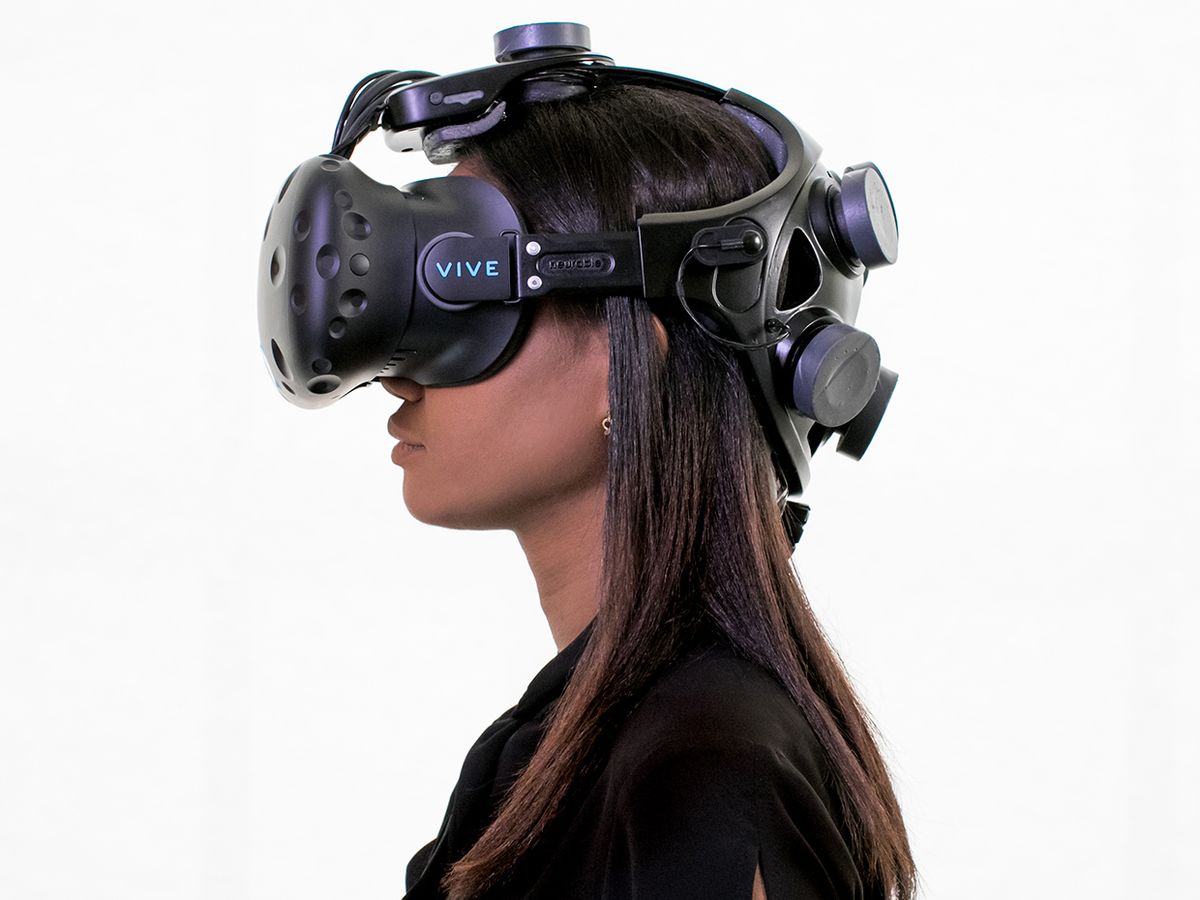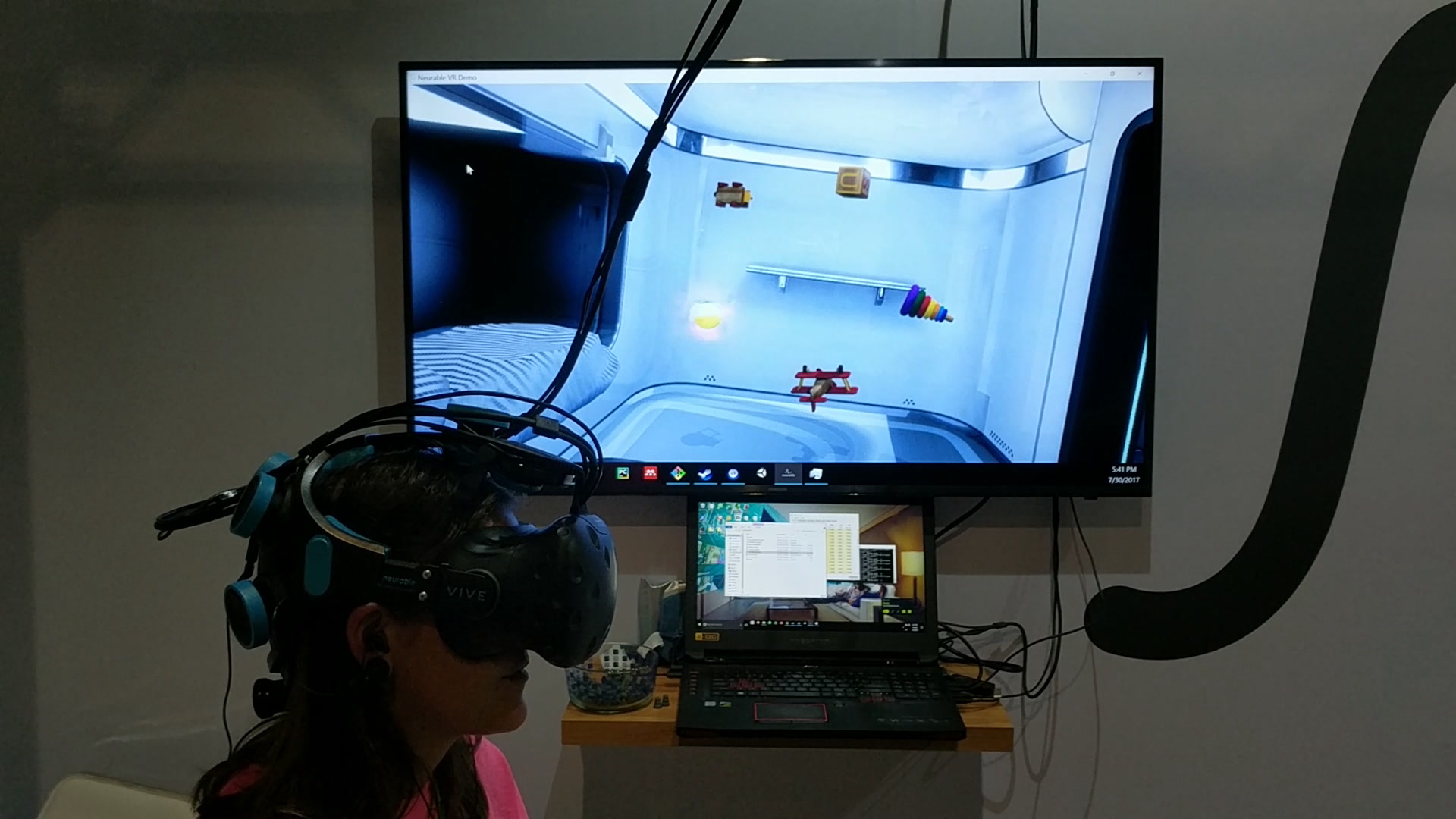The First Mind-Controlled VR Game Will Hit Arcades in 2018
Neurable’s brain-scanning headband brings hands-free control to virtual reality entertainment

“Wake up, this is not a test,” intones a voice as the virtual reality game Awakening begins. Your game character is a child trapped in a nefarious government lab, and as you scan the room you see a variety of objects lying on the floor, each flashing with light. You focus your mental attention on a block, and it rises up and rotates in the air before you. Then you focus on a mirror on the wall, and the block hurtles toward it and smashes the glass, revealing a scrawled sequence of numbers beneath. You notice a keypad by the door with numbers that are also subtly flashing. Using only your Jedi powers, you focus on certain digits in the correct sequence to open the door.
The technology that makes this game possible is a brain-scanning headband that attaches to a VR headset. That headband, paired with software that interprets the neural signals, enables wearers to play games without using any sort of hand controller. The creators of this brain-computer interface system, at the Boston-based startup Neurable, believe this intuitive controller will be the next big thing in VR. “We’ve essentially created a brain mouse,” says Ramses Alcaide, Neurable’s cofounder and CEO.
Awakening is the world’s first brain-controlled VR game. And curious gamers will get a chance to play it later in 2018 when Neurable’s game will arrive in VR arcades around the world.
The headband incorporates seven bulky electrodes that record EEG (electroencephalography) signals, a standard method of monitoring the electrical activity of broad swaths of brain cells. To detect the user’s intention, Neurable’s system makes clever use of a type of brain signal called an event-related potential. As you focus on a toy block that’s pulsing with light, for example, your brain subconsciously registers its particular pattern of flashes, and certain neurons “fire” in response. Neurable’s software processes the noisy EEG data, finds the signal therein, and translates it into a game command: Use the block.
Neurable chose to use flashing objects and the associated neural signals because its EEG system’s scalp electrodes can reliably pick up those brain patterns. Neuroscientists haven’t yet figured out how to detect signals that would allow for more direct control (such as a signal that means “move the block to the left”) without resorting to surgically implanted electrodes.

Alcaide says that Awakening isn’t very sophisticated in its story line. He explains that Neurable hired a VR graphics company to create the game merely as a demonstration of the technology. But the company is now offering a developer’s kit that game designers can use to devise all manner of entertainments and experiences, and he is looking forward to seeing what third-party developers will dream up. “We’re not game designers; we don’t know how to lead players through these environments,” Alcaide says. “The narrative is the hard part, not the technology.” While the current EEG headband fits best with the HTC Vive headset, it’s also compatible with other VR systems.
Rolling out the game in VR arcades is a smart strategy, says Jitesh Ubrani, an analyst at the research firm IDC, headquartered in Framingham, Mass., who coauthored a recent VR market report. Ubrani says the high price of VR headsets has prevented widespread adoption, particularly because consumers don’t have many opportunities to try before they buy. “I think VR arcades will play a very important role,” Ubrani says. “They make it easy for people to try it out and learn about the VR experience.” While only a handful of such arcades have opened in the United States and Europe, Ubrani says they’re already “hugely popular” in China and elsewhere in East Asia.
Neurable isn’t the only company aiming to make a more intuitive interface for VR. Ubrani notes that companies like Leap Motion, based in San Francisco, are working on hand-tracking systems that allow for gesture-based interfaces. Such systems, expected to debut in the next few years, also aim to replace handheld controllers and might seem more natural to gamers than Neurable’s brain-control system.
Neurable’s Alcaide says he isn’t worried, because he sees VR games as just the first application of his company’s technology. To make the system more versatile, Alcaide says its hardware will evolve to become less obtrusive: He envisions first a headband with only one or two small EEG electrodes, and eventually an EEG sensor that fits snugly into an earbud.
Those discrete sensors could then be used with augmented reality (AR) glasses, which layer virtual reality on a view of the real world. If such glasses catch on for commercial or consumer use, Neurable’s technology would enable interaction without using a smartphone, gesturing, or issuing voice instructions. Instead, users would just focus their attention on a menu command, a “record” button, or whatever else they wanted to click on. “EEG offers a screen-free solution that’s private,” Alcaide says. “You won’t have to wave your arms around or talk out loud on the bus.”
This article appears in the January 2018 print issue as “Mind Games.”